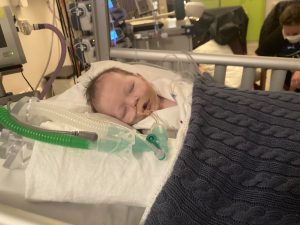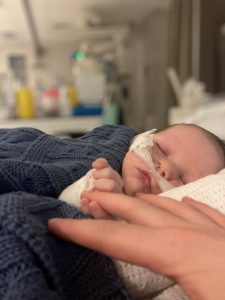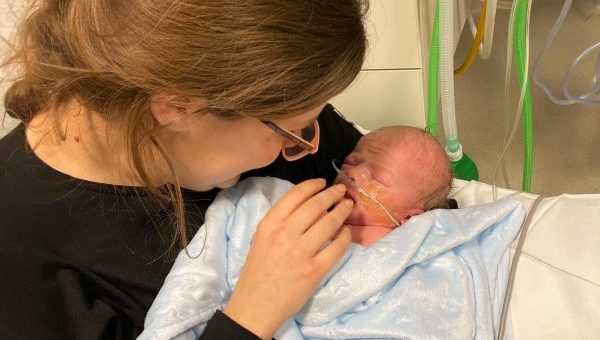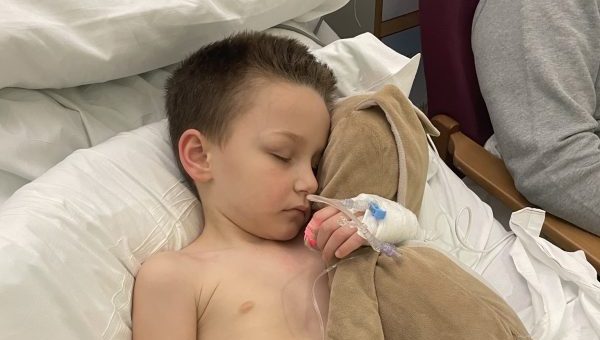After a relatively straightforward birth, we had been enjoying life as a new family of four with our son Cahal at our home in Wanstead. However, when Cahal was just five weeks old, we noticed that he was a bit poorly and under the weather. Being wintertime we thought it was a cold and nothing more serious than that. We assumed that his older sister Niamh may have brought something home from nursery, which is easily done. It soon became clear that his cough and breathing were getting worse, which is when we decided to take him to our GP for a check-up.

The doctor was quite concerned for his health and quickly called for an ambulance. Cahal and I were blue lighted to Whipps Cross University Hospital in East London, where he was immediately admitted to the children’s A&E ward. He was really struggling with his breathing, with his cough also becoming more severe. After investigations he was soon diagnosed with bronchiolitis, a serious chest infection which can often result in hospital treatment for young children and babies. Cahal’s fight against the infection left him utterly exhausted, with his tiredness affecting his ability to feed, which only made things worse. The decision was made therefore to intubate him, ensuring that his body didn’t have to work so hard.
It was clear that Cahal needed specialist treatment, so arrangements were being made for us to be transferred by the Children’s Acute Transport Service (CATS) team. This is a special ambulance service which transports paediatric critical care patients to specialist hospitals. As it was a case of moving him to a hospital with an available bed, we had no idea where we might be transferred to, which was both confusing and worrying for us. Thankfully Cahal was taken to the Royal London Hospital, the closest specialist hospital to our home in Wanstead. It was his second blue-light ambulance journey in one day and he was admitted to the paediatric intensive care unit (PICU) on arrival where he continued to be ventilated. For both myself and my partner, James, it was a complete whirlwind and such a worrying time for both of us. Seeing him so lifeless, struggling to breathe and being connected to all the different machines was horrible.
“You never think that you’ll need support from a charity like The Sick Children’s Trust until you’re in that situation, and it really was amazing.”
Having arrived at the Royal London Hospital around midnight, we stayed the night in the hospital’s family accommodation. The following morning while we were updated on how Cahal was doing, the doctors told us that we had a place to stay just minutes from hospital called Stevenson House. It’s a ‘Home from Home’ run by The Sick Children’s Trust, a charity which provides families with a place to stay while their children are seriously ill in hospital. To have such a fantastic facility so close to the hospital was unbelievable. We live over an hour away from the Royal London Hospital, meaning that we would have had to get the tube or drive every day to be with Cahal. It would have made things incredibly hard, being completely at the mercy of either the traffic or relying on the smooth running of public transport. We couldn’t risk that, so would have either slept on the floor or not sleep at all because we simply couldn’t leave him.

You never think that you’ll need support from a charity like The Sick Children’s Trust until you’re in that situation, and it really was amazing. The ‘Home from Home’ was clean, modern, with a comfortable bed and everything else we needed to be able to keep ourselves going. It felt like a big warm hug when we needed it most.
We stayed at Stevenson House for nearly two weeks while Cahal continued his treatment . He was diagnosed with two variants of bronchiolitis, spending four days on the ventilator until his breathing improved. Still needing some support, he was moved onto a cpap machine, which delivers a stream of oxygenated air into the airways through a mask. Unfortunately, he deteriorated again and was back on the ventilator a few days later. All we could do was wait by his side, ensuring he knew we were there, waiting for him to fight off the infections. Small steps were made with a good physio session or positive results from an x-ray, but then things would take a turn for the worse, with his oxygen levels dropping or cough worsening. It felt like two steps forwards, three steps back at times, but we just had to keep taking everything in our stride.

When we did manage to get home, it was only a matter of days before Cahal returned to Whipps Cross Hospital with breathing issues, quickly diagnosed as a third variation of bronchiolitis. Because of everything he had already been through, we spotted the signs a lot sooner. The medical staff there remembered us as well, so they started treating him right away. That made all the difference as he didn’t need to be ventilated, returning home after five days on the cpap machine. Since then, I’m pleased to say that Cahal hasn’t been back to hospital. He will still have regular check-ups with the respiratory consultant due to a constant cough and a crackle in his breathing, but he’s doing really well. We’ll always be so grateful to The Sick Children’s Trust for everything they have done to support us.
Aoife Hannigan, Cahal’s mum.


